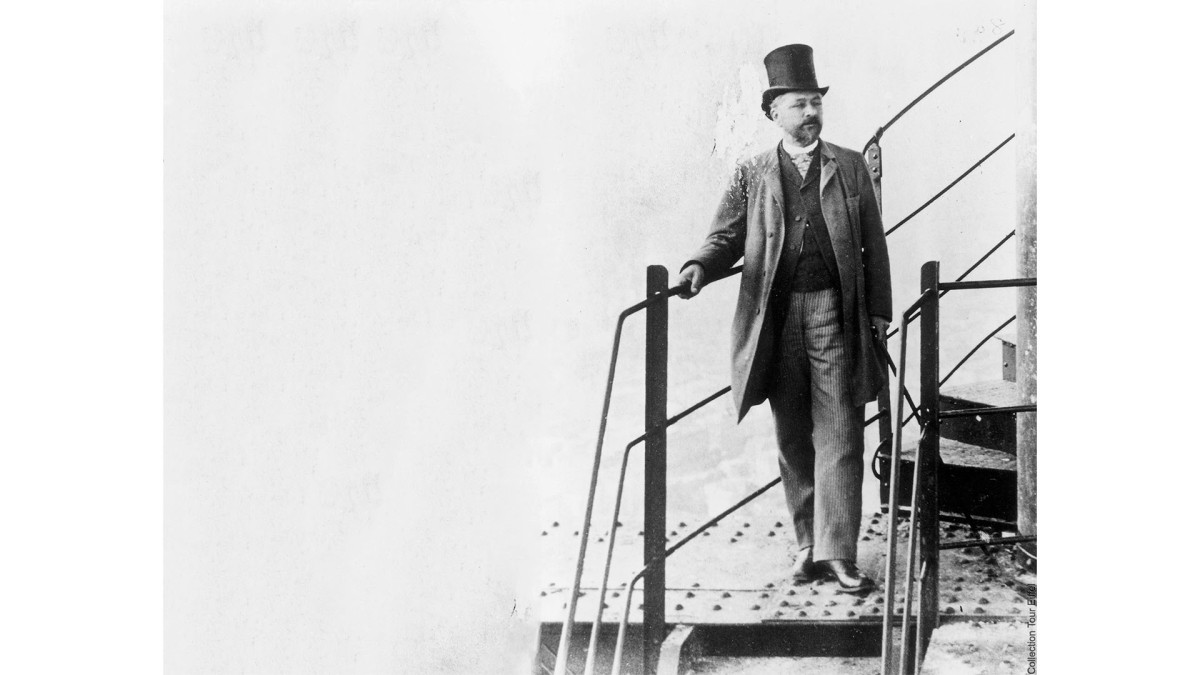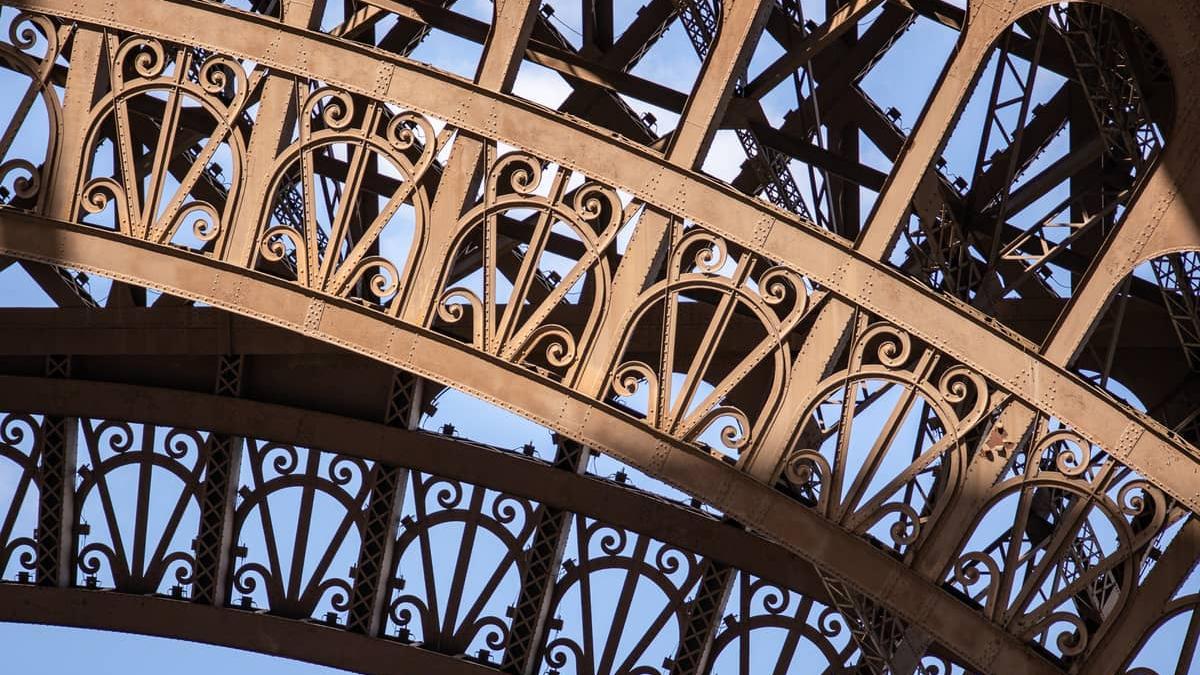It was at the 1889 Exposition Universelle, the date that marked the 100th anniversary of the French Revolution, that a great competition was launched in the Journal Officiel.
The first digging work started on the 26th January 1887. On the 31st March 1889, the Tower had been finished in record time – 2 years, 2 months and 5 days – and was established as a veritable technical feat.
Key figures
| Design | 18,038 metallic parts |
| 5,300 workshop designs | |
| 50 engineers and designers | |
| Construction | 150 workers in the Levallois-Perret factory |
| Between 150 and 300 workers on the construction site | |
| 2,500,000 rivets | |
| 7,300 tonnes of iron | |
| 60 tonnes of paint | |
| 5 lifts | |
| Duration | 2 years, 2 months and 5 days of construction |
The construction schedule
| Works kick-off | 26th January 1887 |
| Start of the pillars' mounting | 1st July 1887 |
| First floor achievement | 1st April 1888 |
| Second floor achievement | 14th August 1888 |
| Top and assembly achievement | 31st March 1889 |
The Design of the Eiffel Tower
The plan to build a tower 300 metres high was conceived as part of preparations for the World's Fair of 1889.

The wager was to "study the possibility of erecting an iron tower on the Champ-de-Mars with a square base, 125 metres across and 300 metres tall". Selected from among 107 projects, it was that of Gustave Eiffel, an entrepreneur, Maurice Koechlin and Emile Nouguier, both engineers, and Stephen Sauvestre, an architect, that was accepted.
Emile Nouguier and Maurice Koechlin, the two chief engineers in Eiffel's company, had the idea for a very tall tower in June 1884. It was to be designed like a large pylon with four columns of lattice work girders, separated at the base and coming together at the top, and joined to each other by more metal girders at regular intervals.
The tower project was a bold extension of this principle up to a height of 300 metres - equivalent to the symbolic figure of 1000 feet. On September 18 1884 Eiffel registered a patent "for a new configuration allowing the construction of metal supports and pylons capable of exceeding a height of 300 metres".
In order to make the project more acceptable to public opinion, Nouguier and Koechlin commissioned the architect Stephen Sauvestre to work on the project's appearance.
A quite different first edition
Sauvestre proposed stonework pedestals to dress the legs, monumental arches to link the columns and the first level, large glass-walled halls on each level, a bulb-shaped design for the top and various other ornamental features to decorate the whole of the structure. In the end the project was simplified, but certain elements such as the large arches at the base were retained, which in part give it its very characteristic appearance.
The curvature of the uprights is mathematically determined to offer the most efficient wind resistance possible. As Eiffel himself explains: "All the cutting force of the wind passes into the interior of the leading edge uprights. Lines drawn tangential to each upright with the point of each tangent at the same height, will always intersect at a second point, which is exactly the point through which passes the flow resultant from the action of the wind on that part of the tower support situated above the two points in question. Before coming together at the high pinnacle, the uprights appear to burst out of the ground, and in a way to be shaped by the action of the wind".
The construction
The assembly of the supports began on July 1, 1887 and was completed twenty-two months later.
All the elements were prepared in Eiffel’s factory located at Levallois-Perret on the outskirts of Paris. Each of the 18,000 pieces used to construct the Tower were specifically designed and calculated, traced out to an accuracy of a tenth of a millimetre and then put together forming new pieces around five metres each. A team of constructors, who had worked on the great metal viaduct projects, were responsible for the 150 to 300 workers on site assembling this gigantic erector set.
The rivet workers
All the metal pieces of the tower are held together by rivets, a well-refined method of construction at the time the Tower was constructed. First the pieces were assembled in the factory using bolts, later to be replaced one by one with thermally assembled rivets, which contracted during cooling thus ensuring a very tight fit. A team of four men was needed for each rivet assembled: one to heat it up, another to hold it in place, a third to shape the head and a fourth to beat it with a sledgehammer. Only a third of the 2,500,000 rivets used in the construction of the Tower were inserted directly on site.

The uprights rest on concrete foundations installed a few metres below ground-level on top of a layer of compacted gravel. Each corner edge rests on its own supporting block, applying to it a pressure of 3 to 4 kilograms per square centimetre, and each block is joined to the others by walls.
On the Seine side of the construction, the builders used watertight metal caissons and injected compressed air, so that they were able to work below the level of the water.
The tower was assembled using wooden scaffolding and small steam cranes mounted onto the tower itself.
The assembly of the first level was achieved by the use of twelve temporary wooden scaffolds, 30 metres high, and four larger scaffolds of 40 metres each.
"Sand boxes" and hydraulic jacks - replaced after use by permanent wedges - allowed the metal girders to be positioned to an accuracy of one millimetre.
On December 7, 1887, the joining of the major girders up to the first level was completed. The pieces were hauled up by steam cranes, which themselves climbed up the Tower as they went along using the runners to be used for the Tower's lifts.
Record construction time
It only took five months to build the foundations and twenty-one to finish assembling the metal pieces of the Tower.
Considering the rudimentary means available at that period, this could be considered record speed. The assembly of the Tower was a marvel of precision, as all chroniclers of the period agree. The construction work began in January 1887 and was finished on March 31, 1889. On the narrow platform at the top, Eiffel received his decoration from the Legion of Honour.
months to build the foundations
5
The numberLe journaliste Émile Goudeau visitant le chantier au début de 1889 en décrit ainsi le spectacle.
"Une épaisse fumée de goudron et de houille prenait à la gorge, tandis qu'un bruit de ferraille rugissant sous le marteau nous assourdissait. On boulonnait encore par là ; des ouvriers, perchés sur une assise de quelques centimètres, frappaient à tour de rôle de leur massue en fer sur les boulons (en réalité les rivets) ; on eût dit des forgerons tranquillement occupés à rythmer des mesures sur une enclume, dans quelque forge de village ; seulement ceux-ci ne tapaient point de haut en bas, verticalement, mais horizontalement, et comme à chaque coup des étincelles partaient en gerbes, ces hommes noirs, grandis par la perspective du plein ciel, avaient l'air de faucher des éclairs dans les nuées."
Mr. Eiffel’s Blueprints
The following blueprints are copies of Gustave Eiffel’s originals, taken from the book La Tour de 300 mètres, Ed. Lemercier, Paris 1900
Debate and controversy surrounding the Eiffel Tower
Even before the end of its construction, the Tower was already at the heart of much debate. Enveloped in criticism from the biggest names in the world of Art and Literature, the Tower managed to stand its ground and achieve the success it deserved.

Various pamphlets and articles were published throughout the year of 1886, le 14 février 1887, la protestation des Artistes.
The "Protest against the Tower of Monsieur Eiffel", published in the newspaper Le Temps, is addressed to the World's Fair's director of works, Monsieur Alphand. It is signed by several big names from the world of literature and the arts : Charles Gounod, Guy de Maupassant, Alexandre Dumas junior, François Coppée, Leconte de Lisle, Sully Prudhomme, William Bouguereau, Ernest Meissonier, Victorien Sardou, Charles Garnier and others to whom posterity has been less kind.

Other satirists pushed the violent diatribe even further, hurling insults like : "this truly tragic street lamp" (Léon Bloy), "this belfry skeleton" (Paul Verlaine), "this mast of iron gymnasium apparatus, incomplete, confused and deformed" (François Coppée), "this high and skinny pyramid of iron ladders, this giant ungainly skeleton upon a base that looks built to carry a colossal monument of Cyclops, but which just peters out into a ridiculous thin shape like a factory chimney" (Maupassant), "a half-built factory pipe, a carcass waiting to be fleshed out with freestone or brick, a funnel-shaped grill, a hole-riddled suppository" (Joris-Karl Huysmans).

Once the Tower was finished the criticism burnt itself out in the presence of the completed masterpiece, and in the light of the enormous popular success with which it was greeted. It received two million visitors during the World's Fair of 1889.
Extrait de la "Protestation contre la Tour de M. Eiffel", 1887
"Nous venons, écrivains, peintres, sculpteurs, architectes, amateurs passionnés de la beauté jusqu'ici intacte de Paris, protester de toutes nos forces, de toute notre indignation, au nom du goût français méconnu, au nom de l'art et de l'histoire français menacés, contre l'érection, en plein cœur de notre capitale, de l'inutile et monstrueuse tour Eiffel, que la malignité publique, souvent empreinte de bon sens et d'esprit de justice, a déjà baptisée du nom de tour de Babel. (...)
La ville de Paris va-t-elle donc s'associer plus longtemps aux baroques, aux mercantiles imaginations d'un constructeur de machines, pour s'enlaidir irréparablement et se déshonorer ? (...). Il suffit d'ailleurs, pour se rendre compte de ce que nous avançons, de se figurer un instant une tour vertigineusement ridicule, dominant Paris, ainsi qu'une noire et gigantesque cheminée d'usine, écrasant de sa masse barbare (...) tous nos monuments humiliés, toutes nos architectures rapetissées, qui disparaîtront dans ce rêve stupéfiant.
Et, pendant vingt ans, nous verrons s'allonger sur la ville entière, frémissante encore du génie de tant de siècles, nous verrons s'allonger comme une tache d'encre l'ombre odieuse de l'odieuse colonne de tôle boulonnée".
La réponse de Gustave Eiffel
Eiffel répond à la protestation des artistes dans une interview accordée au Temps le 14 février 1887 qui résume bien sa doctrine artistique :
"Je crois, pour ma part, que la Tour aura sa beauté propre. Parce que nous sommes des ingénieurs, croit-on donc que la beauté ne nous préoccupe pas dans nos constructions et qu'en même temps que nous faisons solide et durable, nous ne nous efforçons pas de faire élégant ? Est-ce que les véritables conditions de la force ne sont pas toujours conformes aux conditions secrètes de l'harmonie ? (...) Or de quelle condition ai-je eu, avant tout, à tenir compte dans la Tour ? De la résistance au vent.
Eh bien ! Je prétends que les courbes des quatre arêtes du monument, tel que le calcul les a fournies (...) donneront une grande impression de force et de beauté ; car elles traduiront aux yeux la hardiesse de la conception dans son ensemble, de même que les nombreux vides ménagés dans les éléments mêmes de la construction accuseront fortement le constant souci de ne pas livrer inutilement aux violences des ouragans des surfaces dangereuses pour la stabilité de l'édifice. Il y a, du reste, dans le colossal une attraction, un charme propre, auxquelles les théories d'art ordinaires ne sont guère applicables".













